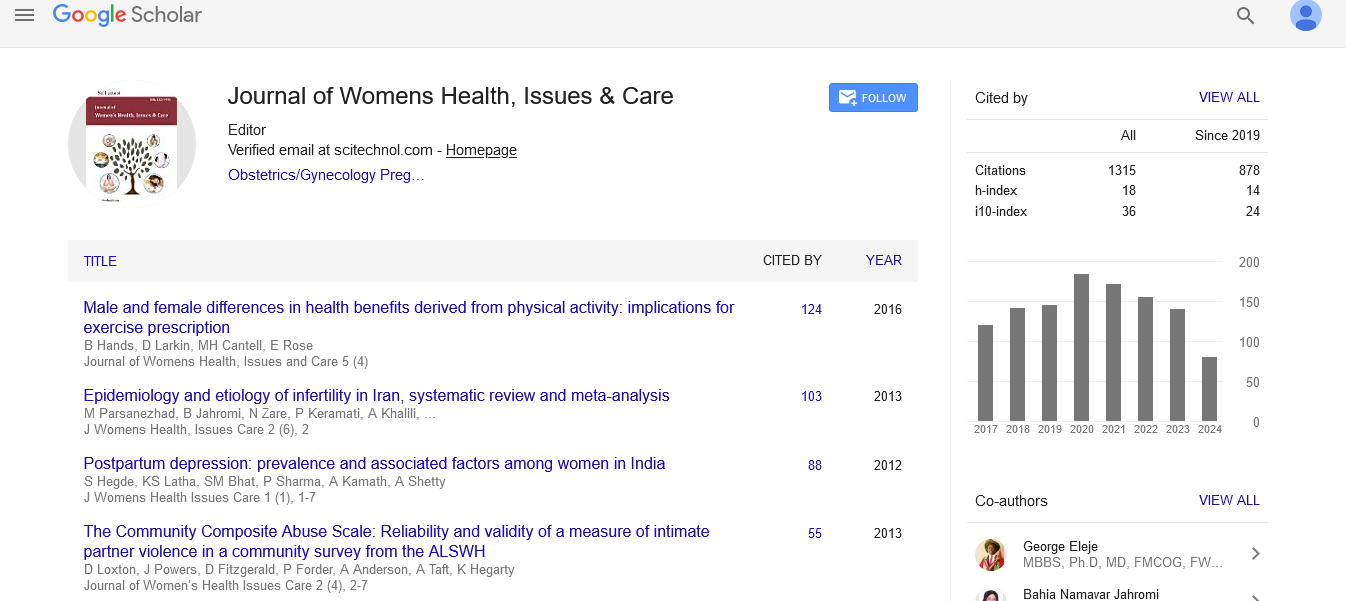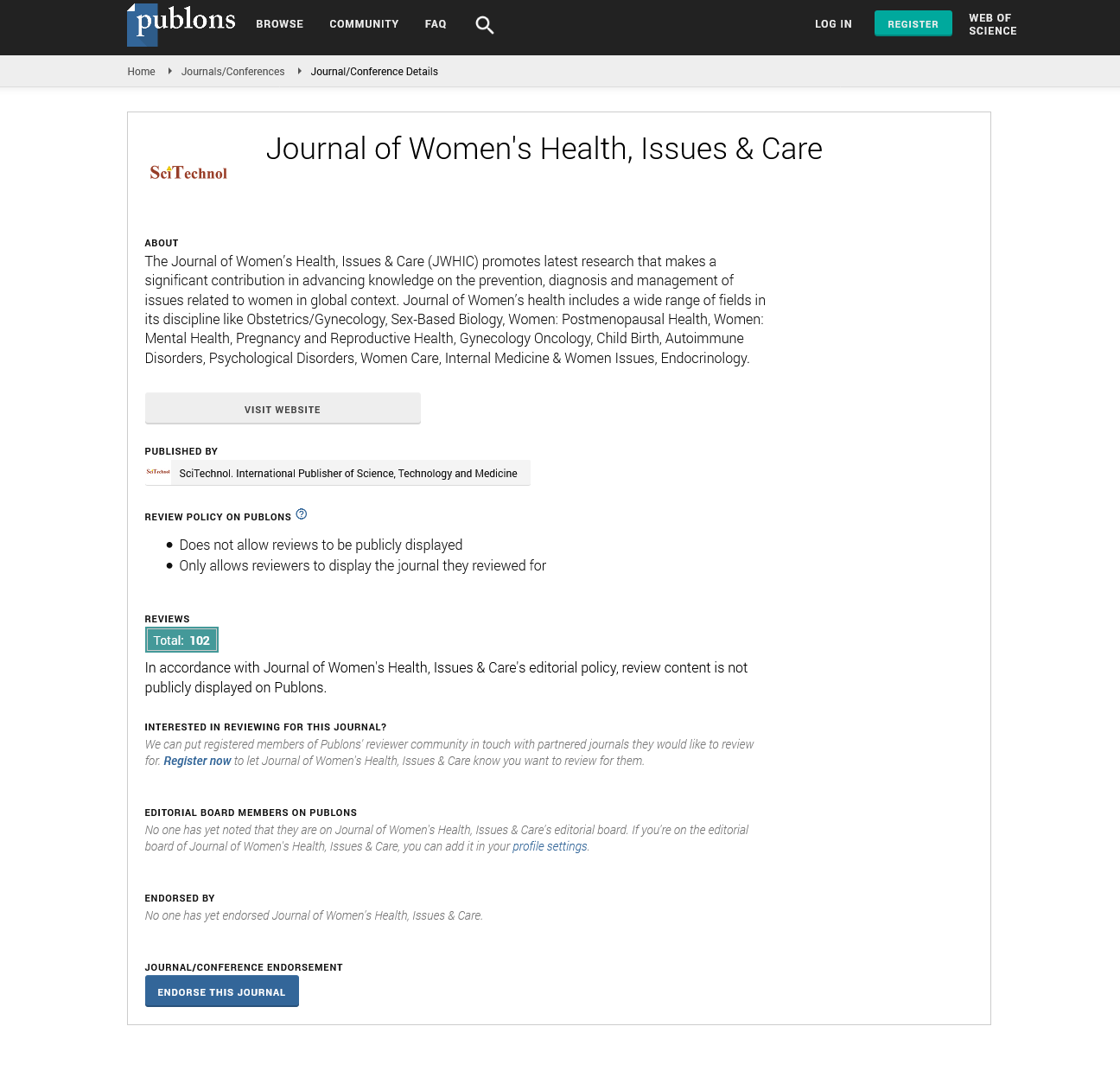Opinion Article, J Womens Health Vol: 13 Issue: 6
Heart Disease in Women: Risk Factors and Prevention
Jivith Gaur*
1Department of Clinical Cardiology, Sri Jayadeva Institute of Cardiovascular Sciences and Research, Bangalore, India
*Corresponding Author: Jivith Gaur,
Department of Clinical Cardiology, Sri
Jayadeva Institute of Cardiovascular Sciences and Research, Bangalore, India
E-mail: Jivith_ga.ur3689@gmail.com
Received date: 26 November, 2024, Manuscript No. JWHIC-24-156658;
Editor assigned date: 28 November, 2024, PreQC No. JWHIC-24-156658 (PQ);
Reviewed date: 12 December, 2024, QC No. JWHIC-24-156658;
Revised date: 20 December, 2024, Manuscript No. JWHIC-24-156658 (R);
Published date: 27 December, 2024, DOI: 10.4172/2325-9795.1000531.
Citation: Gaur J (2024) Heart Disease in Women: Risk Factors and Prevention. J Womens Health 13
Description
Heart disease is a leading cause of death among women worldwide, often surpassing other conditions such as cancer. Despite its prevalence, the risk factors and presentation of heart disease in women are frequently under-recognized, leading to delayed diagnosis and treatment. Addressing this issue requires a thorough understanding of the unique risk factors women face and the strategies that can be implemented for prevention. The risk factors for heart disease in women include both traditional and gender-specific contributors. Common factors such as high blood pressure, high cholesterol, diabetes, smoking and obesity are well-known reasons that increase cardiovascular risk. However, women often experience additional risks related to hormonal changes, pregnancy and autoimmune diseases. Hormonal fluctuations throughout life, particularly during menopause, result in a decrease in estrogen levels, which has protective effects on heart health. This loss increases the likelihood of developing cardiovascular diseases, especially as women age. Pregnancy-related complications further contribute to the risk of heart disease. Conditions such as preeclampsia, gestational diabetes and preterm birth not only affect immediate pregnancy outcomes but also have long-term implications for cardiovascular health. Women with a history of these complications are at a higher risk of developing hypertension, coronary artery disease and heart failure later in life. Unfortunately, the connection between these pregnancy complications and heart disease is often overlooked in routine healthcare.
Autoimmune diseases, which disproportionately affect women, also play a significant role in heart disease risk. Conditions such as lupus and rheumatoid arthritis are associated with chronic inflammation, which damages blood vessels and accelerates atherosclerosis. This heightened inflammatory state can lead to an increased prevalence of heart attacks, strokes and other cardiovascular complications in women with autoimmune disorders. Psychosocial factors also contribute to heart disease in women. Stress, anxiety and depression are more commonly reported in women and can negatively impact heart health by causing unhealthy behaviors such as poor diet, physical inactivity and smoking. Chronic stress, in particular, is linked to increased levels of cortisol and other stress hormones, which contribute to hypertension and inflammation. The presentation of heart disease in women often differs from that in men, leading to challenges in diagnosis and treatment. While chest pain is the main symptom of a heart attack in men, women may experience atypical symptoms such as fatigue, shortness of breath, nausea and pain in the back, neck or jaw. These non-specific symptoms are frequently misattributed to other conditions, delaying the identification and management of heart disease in women. Prevention of heart disease in women requires a comprehensive and individualized approach that addresses both traditional and gender-specific risk factors.
Lifestyle modifications are fundamental in reducing cardiovascular risk. Regular physical activity, a balanced diet rich in fruits, vegetables and whole grains and maintaining a healthy weight are essential components of prevention. Smoking cessation is particularly important for women, as smoking not only damages blood vessels but also diminishes the protective effects of estrogen. For women with diabetes or high blood pressure, effective management of these conditions is critical to reducing cardiovascular risk. Routine monitoring of blood glucose levels, blood pressure and cholesterol can help identify early signs of heart disease and enable timely interventions. Raising awareness about the unique risks and symptoms of heart disease in women is another key aspect of prevention. Healthcare providers should prioritize education and screening, especially for women with a history of pregnancy complications or autoimmune disorders. Incorporating routine cardiovascular risk assessments into gynecological and primary care visits can help identify at-risk individuals and guide preventive strategies.
Conclusion
Heart disease in women is a multifaceted issue influenced by traditional, hormonal and psychosocial factors. Prevention requires a proactive approach that combines lifestyle changes, effective management of medical conditions and increased awareness of gender-specific risks. By addressing these aspects comprehensively, it is possible to reduce the burden of heart disease among women and improve their overall cardiovascular health.
 Spanish
Spanish  Chinese
Chinese  Russian
Russian  German
German  French
French  Japanese
Japanese  Portuguese
Portuguese  Hindi
Hindi 



